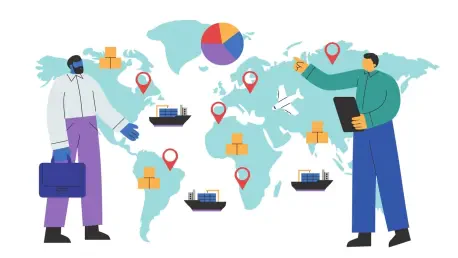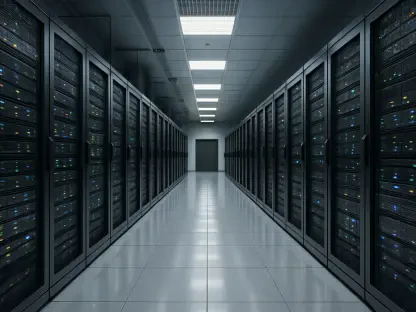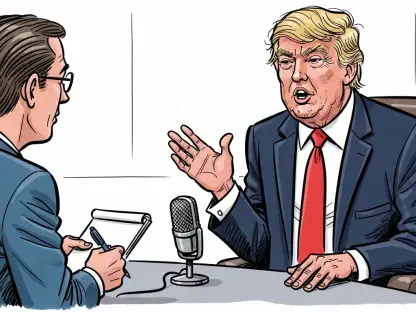Donald Gainsborough is a well-respected leader in policy and legislation, known for his deep understanding of the complexities involved in international trade. He offers keen insights into the strategies behind foreign trade decisions, particularly how nations maneuver through economic tensions on the global stage. As the head of Government Curated, Gainsborough adeptly navigates intricate trade dynamics, making him the ideal person to illuminate the current US-China tariff situation and its myriad implications for global markets.
How is China selecting the US-made goods that are exempt from its 125% tariffs?
China’s approach in choosing US products for tariff exemption reflects a strategic, almost surgical precision. It focuses on critical goods that sustain its economic interests, like pharmaceuticals and semiconductors. The exemption list is populated by items that bolster vital sectors and support technological growth. This selection process is communicated to companies through discreet channels, allowing them to plan around new trade realities without the noise that public announcements might generate.
What is the purpose behind China tactically easing tariffs on certain US products while maintaining a strong public stance?
China’s tactical easing is a calculated move aimed at reducing internal pressures without altering its firm diplomatic tone. By easing tariffs on essential US goods, especially in technology and pharmaceuticals, China can maintain healthy industrial growth while signaling openness to negotiation behind closed doors. This approach creates a buffer that might not shake the status quo publicly but contributes significantly to stabilizing domestic economic health.
President Trump mentioned that China would likely ‘eat’ the costs. What does he mean by this?
When Trump says China will ‘eat’ the costs, he suggests China will bear the financial burden of the tariffs rather than passing them directly to consumers. This implies China may absorb these tariffs or subsidize costs to keep prices stable in the US market. Still, US consumers might feel indirect effects, particularly through shifts in product availability or subtle price adjustments, as companies adjust their supply chain strategies.
There are reports of supply shortages and layoffs due to tariffs. Which industries are most affected?
Industries deeply enmeshed with logistics and retail, as well as those reliant on imported materials, are particularly vulnerable. The trucking and shipping sectors are facing immediate challenges, with layoffs looming as companies grapple with declining shipments. Forecasts suggest a continued tightening in these areas, leading to cascading effects across related sectors that depend heavily on timely and affordable imports.
Trump signed an order offering tariff relief in the automotive sector. Why was this decision made?
Trump’s decision to offer tariff relief in the automotive sector was driven by intense industry lobbying, highlighting severe implications for sales and consumer prices. Automakers warned of the repercussions if tariffs persisted, including decreased competitiveness and increased prices for consumers. The industry’s response has been cautiously optimistic, with companies eyeing improved sales forecasts and a temporary easing in production costs.
Commerce Secretary Howard Lutnick mentioned being close to a trade deal with an unnamed country. Can you elaborate on the progress of this deal and which country it might involve?
Lutnick’s comments point towards significant progress in negotiations, and while the country remains unnamed, indicators suggest it might be India, given the recent acceleration in discussions there. The progress reflects mutual interest in expanding trade ties, potentially leading to landmark agreements that align with broader strategic goals. Such deals could significantly shift the current dynamics and reset trade relationships with key partners.
How is the Trump administration’s tariff policy affecting US trade relations with countries like India, Japan, and South Korea?
The tariff policy has introduced layers of complexity in dealings with these nations, prompting renegotiations and reassessments of existing economic agreements. While some negotiations are actively underway, the broader uncertainty challenges traditional trade patterns and necessitates exploring new frameworks that enable continuity and growth despite tariff-induced complications.
What impact are US tariffs having on international companies like Shein and Samsung?
For companies like Shein and Samsung, US tariffs are forcing operational recalibrations, affecting everything from supply chain logistics to pricing strategies. Shein, particularly vulnerable due to its reliance on direct shipping from China, is looking at structural changes to mitigate the tariff impact on its US operations. Samsung faces slower profit growth as uncertainty prompts reduced spending on AI hardware, which could lead to a strategic reallocation of resources.
How are global automakers, like Aston Martin and Mercedes-Benz, responding to US tariffs on vehicles and parts?
Global automakers are adopting varied strategies to counteract these tariffs. Aston Martin is reducing exports to the US to preserve margins, while companies like Mercedes-Benz are adjusting projections and reassessing capital expenditure plans. These strategies are geared towards maintaining market presence while absorbing potential economic hits from persistent tariffs.
How are China’s tariffs impacting US export markets, particularly in states like Texas and California?
States with high export volumes to China, like Texas and California, are witnessing significant economic reverberations due to China’s retaliatory tariffs. This has led to job insecurities and raised concerns about prolonged economic impacts, especially in industries like agriculture that are heavily reliant on Chinese trade. The ripple effects are prompting local businesses to evaluate alternative markets and strategies to offset losses.
How does Treasury Secretary Scott Bessent’s claim that China could lose 10 million jobs relate to current trade tensions?
Bessent’s assertion underscores the gravity of China’s economic vulnerability amid ongoing trade tensions. This estimate highlights the stakes for China, emphasizing the employment impacts that could ensue if tariffs remain unaddressed. It reflects the intricate balance between political positioning and economic pragmatism, urging for dialogue and resolution to avert detrimental long-term effects.
What is your forecast for the future of US-China trade relations amidst these ongoing tariffs?









